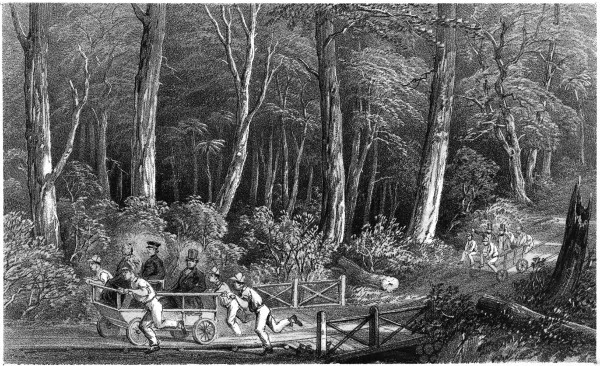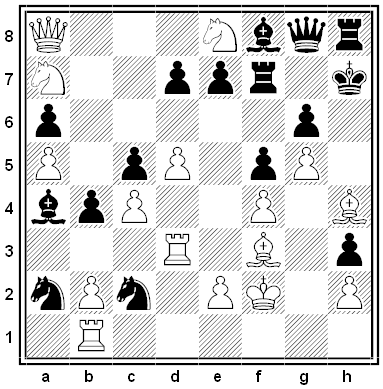If you write out the numbers from 1 to 5000 in American English (e.g., THREE THOUSAND EIGHT HUNDRED SEVENTY-THREE), it turns out that only one of them has a unique number of characters. Which is it? Spaces and hyphens count as characters.
Podcast Episode 88: Mrs. Wilkinson and the Lyrebird
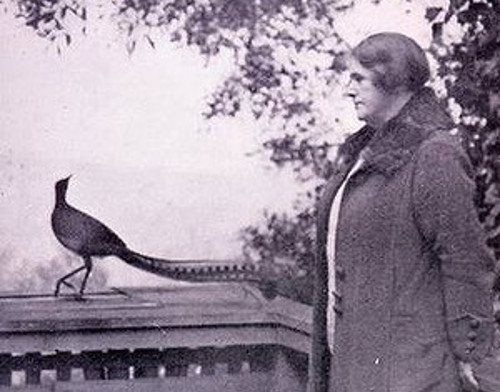
Almost nothing was known about Australia’s elusive lyrebird until 1930, when an elderly widow named Edith Wilkinson encountered one on her garden path one February morning. In this week’s episode of the Futility Closet podcast we’ll follow the curious friendship that evolved between Wilkinson and “James,” which led to an explosion of knowledge about his reclusive species.
We’ll also learn how Seattle literally remade itself in the early 20th century and puzzle over why a prolific actress was never paid for her work.
Progress

Hollinwood, near Manchester, was the scene of a rather novel rat killing match the other day, between Mr. Benson’s fox terrier dog, Turk, and a Mr. Lewis’ monkey, for £5. The conditions of the match were that each one had to kill twelve rats, and the one that finished them the quickest to be declared the winner. You may guess what excitement this would cause in the ‘doggy’ circle. It was agreed that Turk was to finish his twelve rats first, which he did, and in good time, too, many bets being made on the dog after he had finished them. After a few minutes had elapsed it now came the monkey’s turn, and a commotion it caused. Time being called, the monkey was immediately put to his twelve rats, Mr. Lewis, the owner, at the same time putting his hand in his coat pocket and handing the monkey a peculiar hammer. This was a surprise to the onlookers; but the monkey was not long in getting to work with his hammer, and, once at work, he was not long in completing the task set before him. You may talk about a dog being quick at rat killing, but he is really not in it with the monkey and his hammer. Had the monkey been left in the ring much longer you could not have told that his victims had been rats at all — he was for leaving them in all shapes. Suffice it to say the monkey won with ease, having time to spare at the finish. Most persons present (including Mr. Benson, the owner of the dog) thought the monkey would worry the rats in the same manner as the dog does; but the conditions said to kill, and the monkey killed with a vengeance, and won the £5, beside a lot of bets for his owner.
— Illustrated Police News, Sept. 4, 1880
Footwork
The first passenger railway in Australia was powered by convicts. Four-passenger carts ran on hardwood rails from the dock at the head of Norfolk Bay to the main settlement at Port Arthur, some 4.5 miles away. (Click the image to enlarge it.) On steep downhill slopes the carts could reach 30 mph, as observed by Col. Godfrey Mundy on an 1851 visit:
The prisoners seized certain bars crossing the front and back of the carriages, and after pushing them with great toil up a considerable plane, reached the top of a long descent, when, getting up their steam, down they rattled at tremendous speed — tremendous, at least, to lady-like nerves — the chains around their ankles chinking and clanking as they trotted along. … [T]he runners jumped upon the side of the trucks in rather unpleasant proximity with the passengers, and away we all went, bondsmen and freemen, jolting and swaying … a man sitting behind contrived, more or less, to lock a wheel with a wood crowbar when the descent became so rapid as to call for remonstrance.
He added, “Our poor beasts of burthen at the end of the traject seemed terribly jaded, running down with sweat, and saw one of them continually trying to shift his irons from a galled spot on his ankle.” On the return journey that afternoon, the leader asked whether they might stop briefly, as the men had had nothing to eat for 12 hours.
After visiting a similar railway at Ralph Bay Neck in 1847, Lt.-Gov. Sir William Denison wrote, “I must say that my feelings at seeing myself seated, and pushed along by these miserable convicts, were not very pleasant. It was painful to see them in the condition of slaves, which, in fact, they are, waiting for me up to their knees in water.”
(From Robert Hughes, The Fatal Shore, 1987.)
“The Peace Problem”
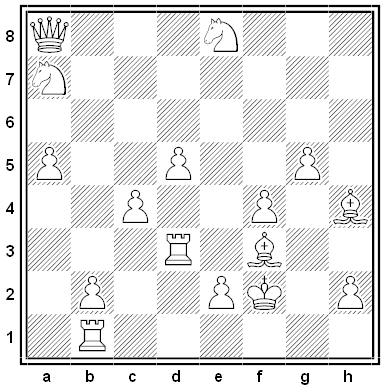
In 1984, at the height of the Cold War, Ukrainian chess journalist F.S. Bondarenko dedicated this puzzle to English chess editor A.J. Roycroft in the spirit of peace and goodwill.
White’s army is arranged as above. Add Black’s army (the standard complement of 8 pieces and 8 pawns) so that no piece of either color is under attack.
Unquote

“Congress is so strange. A man gets up to speak and says nothing. Nobody listens — and then everybody disagrees.” — Russian actor Boris Marshalov, after visiting the House of Representatives
In a Word
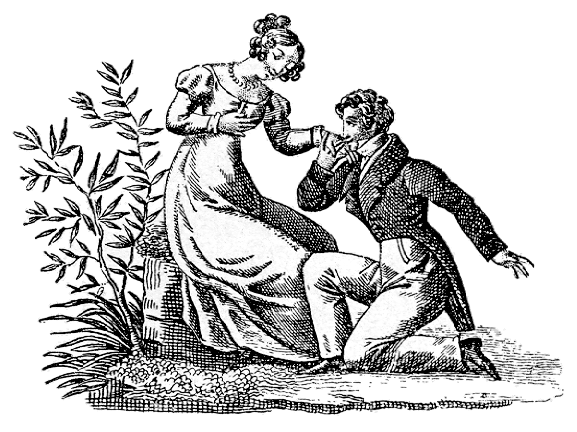
agamy
n. absence of marriage; the state or condition of being unmarried
viripotent
adj. (of a woman) physically fit for marriage
affidation
n. sworn confirmation of one’s intent to marry
deuterogamy
n. marriage a second time
Pascal’s Primes
In Pascal’s triangle, each number is the sum of the two immediately above it:
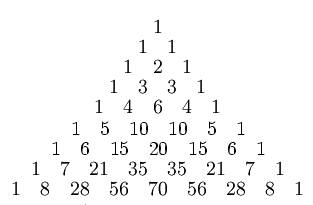
In 1972, Henry Mann and Daniel Shanks found a curious connection between the triangle and prime numbers. Stagger the triangle’s rows so that row n starts at column 2n:

Now a column number is prime precisely when the numbers in that column are each divisible by their row number. For instance, in the diagram above, column 13 has two entries — 10, which is divisible by 5, and 6, which is divisible by 6 — so 13 is prime. The numbers in column 12 are not all evenly divisible by their row numbers, so 12 is not prime.
“It’s a nifty and surprising result,” writes James Tanton in Mathematics Galore! (2012), “but it is not a formula that allows us to find prime numbers with ease.”
(Henry B. Mann and Daniel Shanks, “A Necessary and Sufficient Condition for Primality, and Its Source,” Journal of Combinatorial Theory, Series A 13:1 [1972], 131-134.)
Podcast Episode 87: A Sleuthing Cabbie, Edward VI’s Homework, and a Self-Aware Crow

In this week’s episode of the Futility Closet podcast we’ll share seven oddities from Greg’s research, from Arthur Conan Doyle’s encounter with a perceptive Boston cabbie to a computer’s failed attempts to rewrite Aesop’s fables.
We’ll also hear boxer Gene Tunney’s thoughts on Shakespeare and puzzle over how a man on a park bench can recognize a murder at sea.
All Aboard
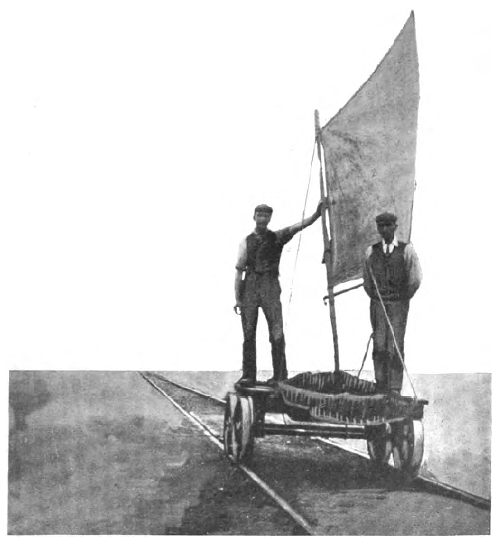
Two more railway oddities. When the local railroad closed its branch, the port of Thames Haven, in southeastern England, devised a trolley driven by the wind. “With a good breeze a speed of from twenty to twenty-five miles an hour can be attained with perfect safety,” reported The Railway Magazine in September 1905. “As can be seen by the photograph, the trolley is an ordinary one, such as are in common use by plate-layers on the railway.”
The second idea is even more dramatic — from Railway World, June 1, 1906:
Despatches from Geneva state that an Austrian engineer, Herr Balderauer, of Salzburg, has been experimenting with much success in the mountains near Salzburg with a novel balloon railway. It consists of a large captive balloon attached to a single steel rail, which in turn is fixed firmly to the side of a steep mountain, whose precipitous slopes no other form of railway could climb without making a series of serpentine detours and passing through tunnels. The balloon remains balanced in the air about ten yards above the rail to which it is attached by a stout wire cable, and it is moved up and down the side of the mountain at the will of the engineer. For an ascent the balloon itself furnishes the lifting force by means of hydrogen; for the descent a large reservoir attached to the balloon is filled with water at the highest station, and serves as ‘ballast.’ Under the balloon is a circular car, seating ten persons. The wire cable from the balloon passes through the floor of the car to a speed regulator underneath, which is controlled by the engineer.
I gather this was actually built, but I haven’t been able to find an image. I’ll keep looking.
12/29/2015 UPDATE: Evidently the balloon system was devised by Salzburg engineers named Balderauer and Brockebusch, who called it the Gebirgsbahn. A reader found this image in Illustrirte Zeitung, Sept. 30, 1897:
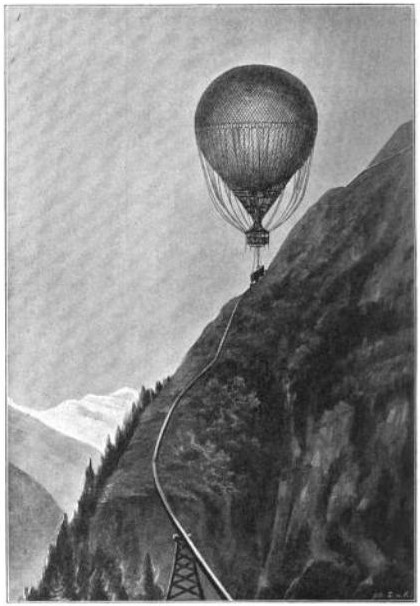
A “strong rope” connected the balloon to the running gear through a large opening in the “wreath-shaped” passenger car. The water reservoir, which could be filled to different heights according to the expected wind strength, was attached to the running gear, with a mechanism for the operator to release water as needed. The railway had a planned capacity of 1500 kg for passengers and aeronauts, and was to include a hangar for storing the balloon during windstorms, during which the operators planned to suspend service.
The inventors took a “small-scale proof-of-concept trip” in 1896, which they deemed “quite satisfactory,” and construction was scheduled for the following spring. In August 1901 New Zealand’s Feilding Star reported that “Not a single accident has occurred during three months of experiments, and the system is without any danger,” but we don’t find any mention of it after that.
(Thanks, Derek and Stephan.)

